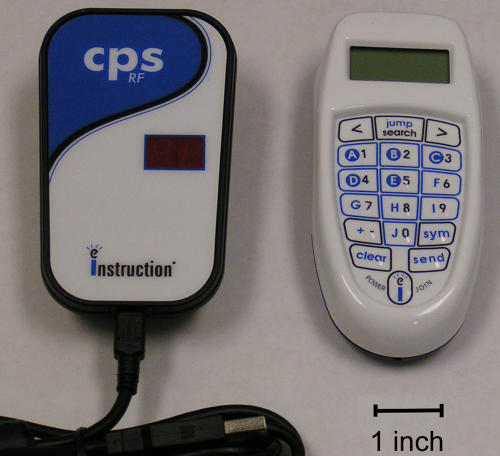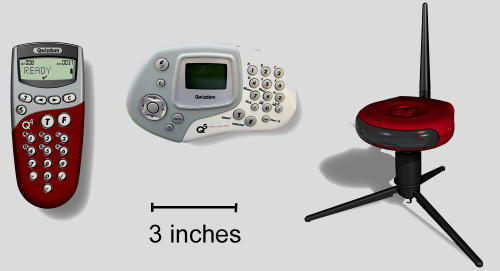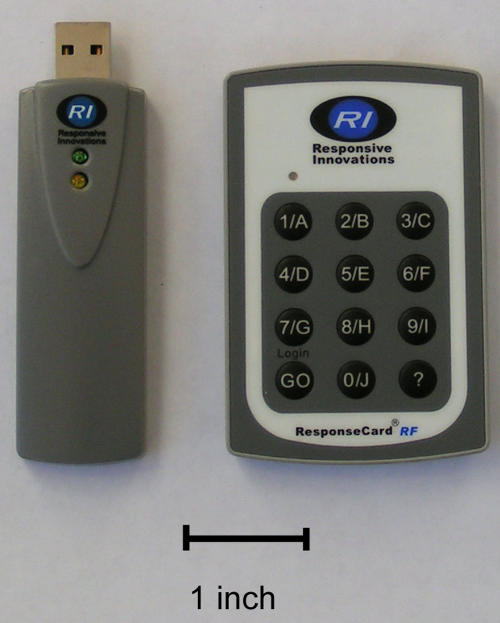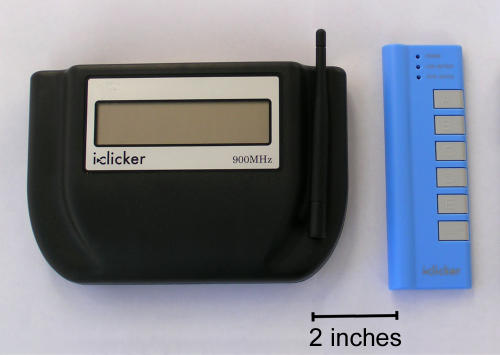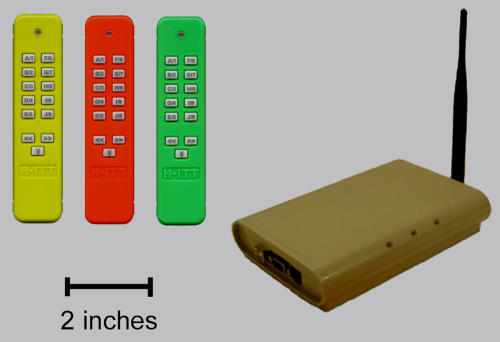Note from the Editor
Use of the audience response devices known as “clickers” is growing, particularly in large science courses at the university level, as evidence for the pedagogical value of this technology continues to accumulate, and competition between manufacturers drives technical improvements, increasing user-friendliness and decreasing prices. For those who have not yet tried teaching with clickers and may have heard unsettling stories about technical problems with earlier models, the decision to use them and the choice of an appropriate brand may be difficult. Moreover, like any classroom technology, clickers will not automatically improve teaching or enhance student learning. Clickers can be detrimental if poorly used, but highly beneficial if good practices are followed, as documented in a growing body of educational literature.
In this Special Feature, we present two reviews that should assist instructors and teachers at all levels in taking the step toward clicker use and choosing an appropriate model. In the first, Barber and Njus compare the features, advantages, and disadvantages of the six leading brands of radio-frequency clicker systems. In the second, Caldwell reviews the pedagogical literature on clickers and summarizes some of the best practices for clicker use that have emerged from educational research. In a related article elsewhere in this issue, Prezsler et al. present the results of a study showing that clicker use can improve student learning and attitudes in both introductory and more advanced university biology courses.
Abstract
Two years after the first low-cost radio-frequency audience response system using clickers was introduced for college classrooms, at least six different systems are on the market. Their features and user-friendliness are evolving rapidly, driven by competition and improving technology. The proliferation of different systems is putting pressure on universities to standardize or otherwise limit the number of different clickers a student is expected to acquire. To facilitate that choice, the strengths and weaknesses of six systems (eInstruction Classroom Performance System, Qwizdom, TurningPoint, Interwrite PRS, iClicker, and H-ITT) are compared, and the factors that should be considered in making a selection are discussed. In our opinion, the selection of a clicker system should be driven by the faculty, although students and the relevant teaching and technology support units of the university must also participate in the dialogue. Given the pace of development, it is also wise to reconsider the choice of a clicker system at regular intervals.
INTRODUCTION
Teaching large classes and trying to keep their students engaged, college faculty across the country are turning to “clickers,” keypads that students use to answer questions posed by the lecturer. Audience response systems (ARS) based on infrared (IR) technology have been available for a while, but low-cost radio-frequency (RF) systems were just introduced in early 2005. Now, only two years later, at least six RF systems are commercially available, and performance has improved considerably. At Wayne State, more of our faculty are experimenting with clickers, and we are faced with making choices to limit the number of different clickers our students need to carry and the university needs to support. Because many are facing the same choices, we would like to share our experiences here.
Our first major venture into clickers was a rather unsatisfying test of an IR system in fall 2004. At considerable expense, we installed IR receivers in several lecture halls, but these receivers proved incapable of handling the volume of responses in big classes (>100 students). Wayne State is a large public university, and bringing active learning into classes with hundreds of students is an important part of our interest in ARS. Keypads using RF signals have always been better suited to large audiences, but their high cost prohibited widespread application. When the first low-cost RF ARS was introduced in January 2005, we immediately switched to it, and we have focused on RF systems ever since. IR receivers are suitable for small classes, and institutions with few large classes might consider using an IR system. However, all major ARS vendors have now introduced low-cost RF keypads, and one has already discontinued its old IR model. The future, therefore, appears to belong to RF.
Although clickers can be used for simply taking attendance or quizzing students to see if they have prepared for class, they are most effective when students are challenged to think about their understanding of the subject. A good question enables the instructor to determine whether or not the class as a whole has grasped a concept correctly. It also empowers individual students to recognize that they have a misconception. This is especially important in science, as a fundamental misconception hinders the student's assimilation of subsequent ideas. However, it is not our purpose to discuss the pedagogical applications of ARS, which are addressed in the accompanying feature article (Caldwell, 2007). The recent literature also has extensive discussions of the use of clickers in active learning (Poulis et al., 1998; Judson and Sawada, 2002; Klionsky, 2002; McClanahan and McClanahan, 2002; Meltzer and Manivannan, 2002; Draper and Brown, 2004; Hatch et al., 2005), assessment (Paschal, 2002), and peer instruction (Fagen et al., 2002; Knight and Wood, 2005). Our objective here is to compare different ARS with regard to features that students, instructors, and universities will need to evaluate in order to choose the most appropriate one for their purposes.
FEATURES OF CLICKER SYSTEMS
How does one decide which clicker system is best? The faculty, students, and the institution as a whole all have a stake in this choice. The faculty will want a system that is convenient to use both as part of a classroom presentation and as a data-gathering and assessment tool. Students want a system that is inexpensive, durable, and infallible when it comes to transmitting their intended responses. As we have evaluated clicker systems, some critical issues have emerged, and these are outlined below. Other recent comparisons have been published (Burnstein and Lederman, 2003) or can be found online. Many of these, however, focus on IR systems, so that, although their discussions of pedagogy may be useful, their comparisons of keypad performance and even software are quickly becoming dated.
Keypad Design.
Students like keypads that are inexpensive and easy to register, but they are especially concerned about getting confirmation that their answers have been transmitted successfully. For this reason, two-way communication and an LCD screen are attractive. Some keypads display the student's answer and confirmation of transmission on the LCD screen; other keypads simply have an LED that indicates that an answer has been transmitted. Most systems also display a voting grid on the classroom screen indicating which students have responded. For classes with large numbers of students, the grid may scroll to keep it from occupying too much of the screen. Students generally also like the voting grid feature. Faculty are interested in the kinds of answers a keypad can transmit. Some want a clicker that offers the option of numeric answers or even text as well as multiple choice. Durability, reliability, and availability of replacement batteries are also important design considerations.
Cost.
The initial price of the keypad varies, and campus-wide standardization or some equivalent arrangement with the vendor may earn students a discount. eInstruction charges an additional fee for registering the unit. The cost of the keypad may be partially recovered in some cases by reselling the used unit to another student or back to the university bookstore.
Compatibility with Presentation Software.
Because many faculty already use PowerPoint presentations in their classes, compatibility of the ARS software with PowerPoint is a crucial consideration. Some applications (iClicker) run alongside PowerPoint (Microsoft, Redmond, WA), having a toolbar floating above the PowerPoint presentation. Others are fully integrated as add-ins to PowerPoint, so question slides and response histograms are displayed within PowerPoint itself. Still others (Classroom Performance System; CPS and H-ITT) display PowerPoint and other applications in a window within their own software. For systems without full PowerPoint integration, questions may be displayed on PowerPoint slides, but the responses are collected and displayed by the system software. With these systems, response data may not be automatically correlated with the question, so the instructor must keep track of questions and reconstruct this association after the fact. iClicker resolves this problem by saving a screen image along with the responses. Some systems have their own presentation software or their own screens for questions and answer selections. In these cases, questions and response data are associated, but the design of the slide may be more limited than in PowerPoint, especially with respect to the arrangement of graphics. This can be a handicap when graphics are used either for the question or for answer selections. A related issue is the use of screen space. Voting grids, response histograms, or questions may be superimposed over the presentation, obscuring information on the screen.
Data Reporting.
All systems are capable of collecting and saving all of the responses of each student (or keypad) to each question. The systems differ in the variety of summary reports and analyses they provide. Some allow questions to be weighted differently; some allow regrading based on a revised set of correct answers.
Registration and Reconciliation of Class Rosters.
The seamless transfer of data from the ARS software to an electronic spreadsheet or grade book requires reconciliation of the roster generated by the ARS with the actual class list. If clickers are used every day in a large class, manual reconciliation of these data is not only time-consuming, but it increases the potential for error. Some systems now advertise that they have a building block creating Blackboard/WebCT (Phoenix, AZ) compatibility. In principle, this should enable facile transfer of data from the ARS software into the instructor's records on the class management system, as opposed to exporting a data file, reconciling the class roster, and then importing the data into the class management system.
Wireless Interference.
To avoid the potential of cross-talk between keypads in one classroom and a receiver in a neighboring classroom, response systems generally have the capability to be set to different channels. The process for changing channels differs, however, some being automatic and some requiring students to set their keypads to the designated channel at the beginning of each class. An associated issue is the process for joining a class. For systems with a fixed roster, each keypad can be matched against the roster, and keypads in adjacent classrooms are ignored. For systems with a flexible roster, stray responses may be collected from keypads operating on the same channel in neighboring classrooms. To avoid this, students are asked to join a session by entering a class ID or by selecting the class from a menu of automatically detected receivers. Keypad manufacturers have adopted different strategies for avoiding interference with wireless microphones, wireless Internet, and other RF devices. Apparently these strategies work; we have not experienced any such interference problems.
Polling and One-Time Use.
When used in classes, clickers are normally registered, so each clicker can be associated with a particular student. It is also useful, however, to have clickers that can be used for polling the audience in one-time events like seminars and meetings. In this case, it is necessary to have clickers that can be activated without registration or the need for a roster. Because the different systems handle registration differently, the polling issue may be handled in one of three ways. eInstruction requires online activation of each clicker, so a separate set of keypads must be purchased for polling use. Other systems require that clickers be registered to be recognized by the receiver, so regular keypads may be used, but their ID numbers must be entered into the ARS software to create a roster before the event. For other systems (iClicker), no registration is necessary, and any keypad may be used for polling.
Training and Technical Support.
Most of the clicker vendors have online technical support. Students find this helpful for solving registration issues. Depending on institutional support, faculty may also rely on technical support for training and help in using the system software. Most vendors will send someone to present a demonstration of their ARS on campus, and this is worth doing before making an adoption decision.
Macintosh Version.
For those faculty who are Macintosh users (Apple Computer, Cupertino, CA), the timely availability of a Mac version, comparable to the current Windows version, is important. This issue may diminish in significance with the advent of Intel Core Duo processors (Mountain View, CA), allowing Apple computers to run both MacOS and Windows. Several of our faculty have already adopted this approach to using the latest clicker software without giving up their Macs for other applications.
Bundling with Textbooks.
Some keypad vendors have formed partnerships with publishers, so students can purchase the keypad bundled with a popular textbook. Although this reduces the cost of the keypad to the student, we believe that the keypad and textbook should be chosen individually on their own merits. The bundle should be selected only in the happy circumstance when both the book and the keypad are the items of choice.
COMPARISON OF SYSTEMS
The currently available RF ARS differ in their performance in each of the above areas. We will discuss them in order of introduction with a description of unique features, cost information, and our assessment of their strengths and weaknesses. Features of the six systems are compared directly in Table 1.
Table 1.
Comparison of ARS
| CPS | Qwizdom | TurningPoint | Interwrite PRS | iClicker | H-ITT | |
|---|---|---|---|---|---|---|
| RF Keypad | ||||||
| LCD screen | Yes: 3 line | Yes: 3 line | No | Yes: 2 line | No | No |
| Multiple choice | A–H | A–F | 1–10 | A–E, T/F | A–E | A–J |
| Numeric | 12 character, decimal, +/− | 13 character, decimal, fraction, +/− | No | 0–9, decimal, +/− | No | 0–9 |
| Text | No | Yes (Q5 only) | No | No | No | No |
| Answer received indicator | LCD | LCD | Green light | LCD | Green light | Green light |
| Unit size | 4.75 × 2.25 × 1.25″ | Q4: 6 × 2.4 × 1.3″ Q5: 6 × 3.5 × 1.6″ | 3.3 × 2.1 × 0.3″ | 6 × 2.5 × 5″ | 6 × 2 × 0.5″ | 5 × 3.5 × 1″ |
| Battery type | 2 AA; slide cover | Q4: 2 AA Q5: rechargeable batteries | 2 CR2032; Screw cover | 3 AAA | 3 AAA, low battery light | One 9-V battery (not included) |
| Suitability for polling | With prepaid registration | Yes | Yes | Yes | Yes | Yes |
| Instructor remote | No | Yes | No | No | Yes | No |
| IR keypad available | Yes | No | Yes | Yes | No | Yes |
| RF Receiver | ||||||
| LCD screen | No | No | No | No | Yes | No |
| USB connection | Yes | Yes | Yes | Yes + one 9-V battery | Yes | Yes |
| Channel selection | Default | Automatic | Default | Automatic | Default | Default |
| Unit size | 4.25 × 2.6 × 1.5″ | 3.5 × 3.5 × 0.5″ | 3.7 × 1.1 × 0.4″ | 4.1 × 3.1 × 1″ | 7.5 × 4.9 × 1.7″ | 7 × 5 × 1.5″ |
| Software | ||||||
| PowerPoint compatibility | Add-in (Windows only) App window | Add-in | Add-in | Add-in | Floating toolbar | App window |
| Data transfer to Excel | Via csv file | Via csv file | Via csv file | Via csv file | Via csv file | Using copy/paste |
| BB, WebCT, WebAssign | Building block | Via csv file | Building block | Building block | Via csv file | Via csv file |
| Operating system | Windows, MacOS | Windows, MacOS | Windows, MacOS | Windows, MacOS | Windows, MacOS native | Windows, MacOS, Linux |
| Other | ||||||
| Registration process | Web-based at eInstruction.com | In class | Locally hosted Enterprise Manager or Blackboard | In class | In class or Web-based | E-mail–based automated system |
| Phone support | 888-333-4988 M–Th, 7 am–6 pm; F, 7 am–5 pm, Central | 800-347-3050 | 866-746-3015 | 800-344-4723 (MD) 800-856-0732 (AZ) | 888-322-0089 | |
| Web support | Chat: M-F, 8 am–5 pmOnline: knowledge base | (Coming soon) | Downloads: software and product guide manuals | Questions: users' forum, training video, users' guide | Documentation, users' guides, software downloads, demo, video clips, WebEx training | Documentation, FAQ, quick start, troubleshooting, best practices |
Classroom Performance System from eInstruction
eInstruction (www.einstruction.com; 888-707-6819; Figure 1) introduced the first low-cost RF system in January 2005. Since then, significant improvements in PowerPoint integration, keypad design, and cost structure have kept CPS competitive with systems introduced more recently. eInstruction's unique online registration makes for good roster generation, but interferes with use of the clickers in polling. McGraw-Hill is a publishing partner.
Figure 1.
CPS receiver (left) and keypad.
Cost.
The keypad itself costs only $16 net to the bookstore, but there is an additional charge for keypad registration each semester. Recently, CPS introduced a lifetime maximum registration fee: $15/term to a maximum of $60 or a one-time fee of $50. For campuses that standardize on CPS, the registration cost is $13/term to a maximum of $39 or a one-time fee of $35. Registration includes all of the courses in which the student is enrolled that semester.
Strengths and Weaknesses.
The new keypad, introduced this past September, has an LCD screen providing students with confirmation of their answers. Like the earlier keypad, it permits numeric responses including a decimal point and a negative sign. eInstruction is unique in charging for registration of the unit, but the recently introduced “Capped Student Pay Per Usage Plan” has significantly reduced the lifetime cost. CPS makes good use of screen space. The voting grid is displayed below the PowerPoint slide. When the response histogram appears, the PowerPoint slide shrinks slightly to make room, so there is no overlap. We have had excellent experience with eInstruction's technical support by phone. Online registration of keypads is easy and effective. A Blackboard building block is available to facilitate transfer of data from CPS to the class gradebook. Alternatively, student scores and attendance can be uploaded to the eInstruction server where students can view grades.
In November 2006, eInstruction introduced CPS for PowerPoint, which provides full integration with PowerPoint. A CPS menu bar, displayed as an add-in to PowerPoint, allows the user to create question slides easily. This version is only available for Windows, however. Macintosh users must still use the older CPS software, which is not completely integrated with PowerPoint. This means that, when using PowerPoint, instructors must use the “verbal question” option. As a result, although the responses are recorded, the question itself is not saved with the data. Alternately, PowerPoint slides can be imported into CPS, but slides cannot be edited. It is also possible to run CPS in parallel with PowerPoint. In this case, CPS displays questions in a relatively rigid and quite limited format. Figures cannot be resized. However, any text entered in this way, even as an impromptu “verbal question,” is saved as part of the CPS data. Because keypads must be registered, single-use audience polling requires a special set of preregistered keypads. The ordinary student keypads require registration for keypad activation, and this precludes their use for one-time events.
Qwizdom
Qwizdom introduced RF keypads with its Q4 model (www.qwizdom.com; 1-800-347-3050; Figure 2) in early 2005. The company has recently introduced a more sophisticated RF keypad—the Q5 version—and has discontinued its Q3 line of IR clickers. Qwizdom's proprietary slide designer, Interact, functions similarly to PowerPoint. PowerPoint slides can be imported into Interact as picture files. As such, they cannot be edited. Alternately, Qwizdom's Actionpoint software functions as an add-in to PowerPoint and appears as a toolbar. Keypads are registered in class by entering the student ID and class ID. If a unit is used in only one class, the student needs to enter the class ID only on the first use. If the unit is used in more than one class, this must be done at each session. Pearson Education, Thomson, Wiley, and Houghton Mifflin are listed as publishing partners.
Figure 2.
Qwizdom Q4 student keypad (left), Q5 instructor keypad (center), and receiver.
Cost.
The Q4 keypad is $49 to the bookstore; instructor packages (Q5 instructor remote, receiver and recharger, software, cables and documentation) cost $525. These prices may be negotiated upon adoption.
Strengths and Weaknesses.
The Qwizdom system features more extensive communication between the instructor and students than the other systems. The student keypad is unique in its ability to send a signal to the instructor's remote. The LCD panel shows the student the answer entered, whether the answer has been received and (if the instructor so chooses) whether the answer is right or wrong. In addition, it displays the right/wrong count for the session. The Q5 keypad is larger than the Q4 and permits text-based answers as well as true/false, multiple choice, and numeric entries. The Q5 unit uses rechargeable batteries. Using either unit, a student can signal a question; the LCD on the instructor's keypad lists the students who have questions. The instructor's keypad, a Q5 model, may also be used to navigate between presentation slides, pause and play media, pose spontaneous questions, view a private response graph, or reveal the graph to the entire class. It also allows selection of a student at random.
Data can be imported into Blackboard or WebCT through a comma separated variable (csv) file, but a Blackboard building block is not available. Macintosh software is limited.
TurningPoint from Turning Technologies
Turning Technologies introduced their credit-card sized RF keypad (www.turningtechnologies.com; 866-746-3015; Figure 3) in June 2005. With its small keypad and seamless PowerPoint integration, the TurningPoint system looks quite advanced technically. TurningPoint features superb compatibility with PowerPoint: a TurningPoint menu bar appears just below the PowerPoint menu bar. Questions are entered directly into PowerPoint slides. Once the type of question is selected, text boxes for answer choices appear automatically. The TurningPoint keypad, called a ResponseCard, is the smallest unit available. The receiver unit is also small, about the size of a flash memory drive. The keypad has 12 buttons including 10 labeled A–J and 0–9. It does not have a decimal point or +/−, however, and does not accept numeric answers. Lacking an LCD screen, the keypad has a green light (LED) to alert students that their answer has been received. A Blackboard building block is available, and it allows students to register their keypads in Blackboard. Student data may also be transferred to class management systems through a csv export file. Thomson Learning and Glencoe/McGraw Hill are listed as publishing partners.
Figure 3.
TurningPoint receiver (left) and keypad (right).
Cost.
The bookstores' cost for ResponseCards is $48 or $44 if the institution has standardized on TurningPoint.
Strengths and Weaknesses.
The great strength of the TurningPoint ARS is the seamless integration with PowerPoint. Because the questions, voting grid, and response histograms are all displayed on the PowerPoint slide, they do not obscure each other. The receiver can be set to collect responses either from any keypad or only from keypads on a specific class list. Therefore, the same keypads may be used for single-event polling and for regular classes. TurningPoint offers sophisticated analysis of student response data. A Macintosh version of the software has just been released.
The small keypads are not very robust in our experience. We have experienced intermittent reception of responses even under very controlled circumstances. The keypad lacks an LCD screen, so communication back to the student is limited to an LED. In addition, registration can be more cumbersome than with some of the other systems. The proprietary registration software, the Enterprise Manager, must be hosted on a local Windows server.
InterWrite PRS from GTCO Calcomp
The Personal Response System (PRS) was introduced by EduCue in an IR version. The RF version (www.gtco.com/prs.htm; 800-344-4723 or 410-381-6688; Figure 4) was introduced after EduCue was acquired by GTCO Calcomp in October 2005. Keypad registration is done in class by entering student ID and the class ID. Keypads can be programmed as student keypads (permanently programmed with student's ID) or as loaners (student ID entered for each session). The student keypads are meant to be purchased by the student; the loaner keypads may be distributed by the instructor to students who forget, misplace, or have other problems with their own keypad. Loaner keypads may also be used for polling audiences at one-time events.
Figure 4.
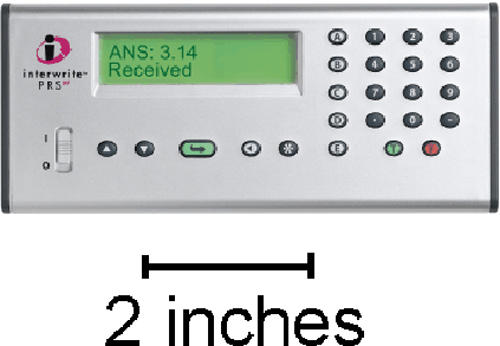
Interwrite PRS keypad.
Cost.
Keypads are $35 to the bookstore; receiver units are $177. Software is licensed to the institution when the units are purchased, and updates are also gratis.
Strengths and Weaknesses.
The keypads are quite sophisticated and permit a wide variety of answer entries including multiple choice, true/false, and numeric. They also accommodate multiple correct answers and rank ordering. The keypad has a unique design with separate keys for T/F, A–E, and numerical answers, with decimal point and negative sign capability. It is also the only system that allows the student to indicate a confidence level for each answer. The LCD screen shows the answer being submitted and indicates when the answer is received. PRS software is fully integrated as an add-in to PowerPoint. A building block is available for transferring data to Blackboard; alternatively, data can be exported in a csv file.
iClicker
iClicker (www.iclicker.com; Figure 5), designed by physicists at the University of Illinois, is a good simple system. The simplicity makes the system easy to use and also means that there is less to go wrong. The keypad, having just five answer buttons (A–E) and an on/off button, does not offer the range of responses possible with some of the more sophisticated systems. The buttons, however, are large and well spaced, so students are less likely to enter the wrong answer by accident. The menu bar floats on top of the other applications, so it is always accessible regardless of the other applications being used. iClicker features a console-style receiver with an LCD display. The LCD gives the instructor a preview of student responses, which the instructor may use to decide whether or not to share the response distribution with the class. A nice feature is that the instructor's keypad can function as a remote control for PowerPoint so the instructor is free to move about the classroom or lecture hall. This does defeat the usefulness of the student response feedback displayed on the receiver, and it would not be an advantage to instructors who use wireless tablets as remote controls. iClicker is now owned by Holtzbrinck Publishers. Other publishing partners listed are Farrar Straus and Giroux, Henry Holt & Company, W. H. Freeman and Worth Publishers, Palgrave Macmillan, Bedford/St. Martin's, Picador, Roaring Brook Press, St. Martin's Press, Tor Books, Scientific American, Nature, and Bedford Freeman & Worth.
Figure 5.
iClicker receiver (left) and keypad (right).
Cost.
The student keypad is $25 to the bookstore; base receivers are $300, but are provided at no cost for every 100 students. Software is included with hardware purchase.
Strengths and Weaknesses.
The software saves screenshots at the time of polling, a feature that is useful for identifying questions, particularly when the instructor poses impromptu questions. The software will also display response distributions for more than one question at a time, allowing for comparison. This may be used, for example, to show the class their collective answers to a question before and after a discussion. The software is native on both Windows and MacOS. The software adds a small menu bar to the screen without interfering with the presentation software. Compatibility with PowerPoint, Word, Flash, and other applications is good. The executable software and data can be stored on a flash memory drive that plugs into the receiver unit. Therefore, if the classroom is equipped with a computer and receiver, the instructor need bring only the flash memory drive. This may be a desirable option, given the relatively large size of the receiver.
The simplicity of the system has some inconveniences. Invalid answers (e.g., E in response to a true/false question) are not excluded, so students can accidentally or intentionally enter meaningless responses. The keypad lacks an LCD display, although the voting grid displayed on the screen can be set to show students the answers they have selected. Both the voting grid and the response histogram superimpose over PowerPoint, so questions may be obscured from view.
H-ITT
H-ITT (Hyper-Interactive Teaching Technology; www.h-itt.com; 321-576-0396) has been marketing IR systems since 2001; their first RF system (Figure 6) was introduced on October 9, 2006. The RF keypads come in three colors and have 10 answer keys (A–J or 0–9). A new, more compact keypad is scheduled for introduction before the beginning of the 2007–2008 academic year. H-ITT uses two separate proprietary applications: Acquisition and Analyzer. To register, students send their instructor an e-mail message containing the student's name, the student's ID, and the unit serial number. The ARS software then mines the data in these messages and creates a class roster. The software accommodates loaner keypads for students who neglect to bring their clicker to class. Pearson: Addison Wesley; Benjamin Cummings, Prentice Hall, Longman, Custom Publishing; Kendall/Hunt Publishing; and Jones & Bartlett Publishers are listed as publishing partners.
Figure 6.
H-ITT keypads (left) and receiver (right).
Cost.
RF keypads are $35 to the bookstore; receiver units are $295. Software is included with hardware purchase.
Strengths and Weaknesses.
The H-ITT system makes effective use of screen space. PowerPoint slides are displayed on one side, and the voting grid and response histograms appear on the other, so nothing is hidden from view. The software is truly cross-platform with native operation on Macintosh, Windows, and Linux, yielding identical appearance. The ARS software will automatically e-mail results to each student. Data can be exported as a csv file for transfer to Blackboard and WebCT.
The PowerPoint compatibility of the H-ITT system is not as sophisticated as that of some of the other products. A third-party integrated PowerPoint called RxShow is available for purchase from Socratec.com. The keypad lacks an LCD screen.
MOVING TOWARD A CAMPUS-WIDE CONSENSUS
Why should an institution adopt a single clicker? First, it reduces the cost to students. Wayne State is an urban university with a large number of working and scholarship students, so keeping costs low is a high priority. We cannot ask students to buy a different clicker (or a different clicker/textbook bundle) for each class. For the institution, standardization reduces the number of systems the university needs to support in terms of faculty training, compatibility with class management tools, and other technical support issues. Standardization also has advantages for faculty. They need only learn a single system, and colleagues can more readily share presentations, technical tricks, and techniques for processing class data. Graduate teaching assistants do not have to become familiar with different systems as they teach in different courses each semester.
The process of choosing a campus-wide clicker system needs to be managed carefully, with input from faculty, students, and the many university offices that will be involved in supporting the system. At some institutions, the adoption of a standard system has been managed by the office responsible for instructional technology or teaching and learning. At Wayne State, the initiative to test and use clicker systems has been largely faculty-driven. Faculty are the primary users, so an ARS must satisfy their expectations if it is to be widely and effectively used. We have been careful, however, to involve our Office of Teaching and Learning (responsible for training), Computer and Instructional Technology (responsible for technical support), and Media Services (responsible for classroom technology). These units must provide guidance as to which clicker systems they can best support, and they must decide how they will provide that support. The campus bookstore too needs to be kept informed so that, assured of continued demand, it will stock enough keypads and be willing to buy back and resell used ones. In some cases, different purchase options are available (keypad only or keypad and registration), and the bookstore must stock the correct option or the appropriate mix.
At Wayne State, we hope to adopt a campus-wide ARS this year, but we have not yet done so. Despite the compelling reasons for standardization, there are good reasons for proceeding with caution. First, it is important to test a clicker system in the classroom to see if it works as expected in your environment. Second, if faculty have a bad first experience with clickers, they will be reluctant to use them again. Therefore, it is imperative that technical support and training be available and that clicker performance match faculty expectations before widespread use is encouraged. Finally, the proliferation of RF systems and rapid improvement in features mean that the system that seems best today may be outmoded tomorrow. Thus, it can be a great challenge to achieve campus-wide consensus for a single ARS, and it is certainly a good idea to reevaluate the clicker choice on a regular basis. Like Mac versus PC, the choice of a clicker system is likely to be an issue that we will debate for years to come.
ACKNOWLEDGMENTS
Figures 2, 4, and 6 are courtesy of Qwizdom, GTCO Calcomp, and H-ITT LLC, respectively.
REFERENCES
- Burnstein R. A., Lederman L. A. Comparison of different commercial wireless keypad systems. Phys. Teacher. 2003;41:272–275. [Google Scholar]
- Caldwell J. E. Clickers in the large classroom: current research and best-practice tips. CBE—Life Sci. Educ. 2007;7:000–000. doi: 10.1187/cbe.06-12-0205. [DOI] [PMC free article] [PubMed] [Google Scholar]
- Draper S. W., Brown M. I. Increasing interactivity in lectures using an electronic voting system. J. Comput. Assist. Learn. 2004;20:81–94. [Google Scholar]
- Fagen A. P., Crouch C. H., Mazur E. Peer instruction: results from a range of classrooms. Phys. Teacher. 2002;40:206–209. [Google Scholar]
- Hatch J., Jensen M., Moore R. Manna from Heaven or clickers from Hell. J. College Sci. Teach. 2005;34:36–39. [Google Scholar]
- Judson E., Sawada D. Learning from past and present: electronic response systems in college lecture halls. J. Comput. Math. Sci. Teach. 2002;21:167–181. [Google Scholar]
- Klionsky D. J. Constructing knowledge in the lecture hall. J. College Sci. Teach. 2002;31:246–251. [Google Scholar]
- Knight J., Wood W. B. Teaching more by lecturing less. Cell Biol. Educ. 2005;4:298–310. doi: 10.1187/05-06-0082. [DOI] [PMC free article] [PubMed] [Google Scholar]
- McClanahan E. B., McClanahan L. L. Active learning in a non-majors biology class. College Teach. 2002;50:92–96. [Google Scholar]
- Meltzer D. E., Manivannan K. Transforming the lecture-hall environment: the fully interactive physics lecture. Am. J. Phys. 2002;70:639–654. [Google Scholar]
- Paschal C. B. Formative assessment in physiology teaching using a wireless classroom communication system. Adv. Physiol. Educ. 2002;26:299–308. doi: 10.1152/advan.00030.2002. [DOI] [PubMed] [Google Scholar]
- Poulis J., Massen C., Robens E., Gilbert M. Physics lecturing with audience paced feedback. Am. J. Phys. 1998;66:439–641. [Google Scholar]



